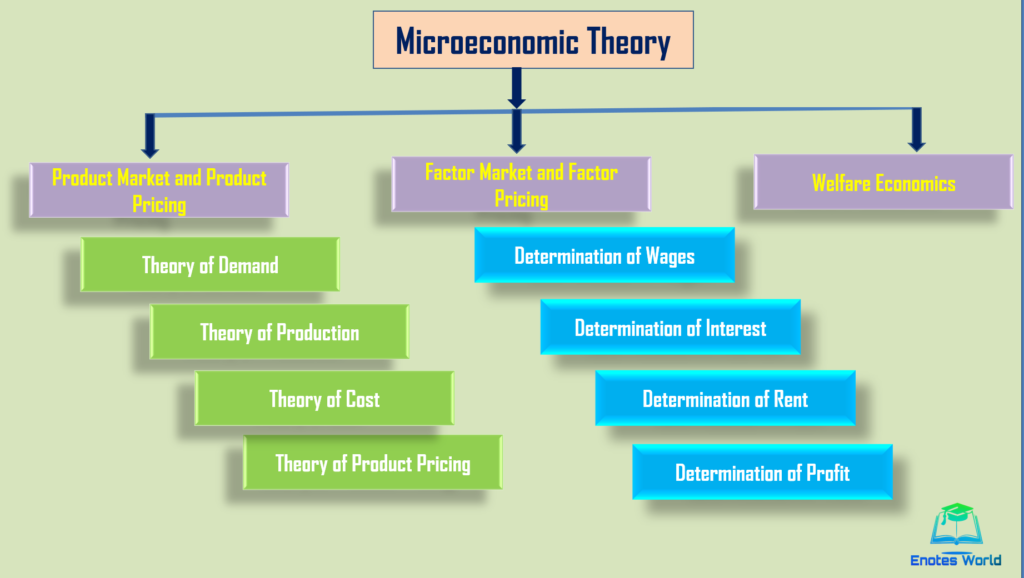Contents
Meaning of Microeconomics
Generally, the subject matter of economics is broadly divided into two main branches. They are microeconomics and macroeconomics. These two words become everyday words nowadays. Microeconomic analysis and macroeconomic analysis are now considered two important approaches to economic analysis.
The terms ‘micro’ and ‘macro’ were first used in economics by Norwegian economist Ragnar Frisch in 1933. These terms were derived from the Greek words ‘mikros’ and ‘makros’ respectively which refer to the small individual unit and large.
Microeconomic theory is a traditional concept. The foundation of microeconomics was ‘Wealth of Nation’ which was published by Adam Smith in 1776. All the economic theories of classical economists were mainly microeconomic in nature. The famous economists of this period were Adam Smith and his followers.
Microeconomics studies the economic behavior of specific economic elements and specific economic variables. The units of study in microeconomics are parts of the economy like households, firms, and industries. Thus, the study of the economic performance of households, firms, and industries creates the subject matter of microeconomics.
Microeconomics is the study of one particular unit rather than all the units combined. Thus, microeconomics consists of looking at the economy through a microscope, to see how the millions of cells in the economy play their part in the working of the whole economic organization.
The following are major definitions relating to the meaning and scope of microeconomics.
“Microeconomic analysis offers a detailed treatment of individual decisions about particular commodities.” (David Ricardo)
“Microeconomics is concerned not with total output, total employment, or total spending, but with the output of particular goods and services by a single firm or an industry and with the spending on particular goods and services by a single household or by household in a single market.” (Edward Shapiro)
“Microeconomics is the study of how households and firms make decisions and how they interact in the market.” (N. Gregory Mankiw,)
Therefore, microeconomics explains how individual economic units such as consumers, resource owners, and business firms play their part in the working of the whole economic system. It is thus the microscopic study of the economy. Instead of studying the whole economy, it takes a small unit of the economy and studies the economic behavior of such part in detail.
Microeconomics is also called price theory as it studies the pricing of goods and services and the factors of production. The basic elements of microeconomics are goods and services, prices, markets, and economic agents like consumers, firms, and government.
Similarly, the basic assumptions of microeconomics are the full employment equilibrium and Ceteris paribus (other things remaining constant). As a result of the postulation of Ceteris paribus, microeconomics is a partial equilibrium analysis. The meaning and scope of microeconomics can be presented as;
Scope of Microeconomics
Microeconomics is the study of individual units of the economy, such as individual consumers, individual firms, and small groups of individual units like various industries and markets.
Thus, the study related to individual units of the economy and small aggregate units such as market demand and industries lies in the scope of microeconomics.
Therefore, microeconomics deals with the determination of product and factor prices and their quantities in the individual markets and the allocation of resources among various firms and industries.
The entire subject matter or scope of microeconomics can be presented in the form of the following chart;

Allocation of Resources
Microeconomics assumes the total quantity of resources is given and it seeks to explain how they are allocated to the production of various goods. Therefore, microeconomics studies the allocation of resources and determines what to produce, how to produce, and for whom to produce.
Theory of Demand
Microeconomics studies how the demand for a commodity is determined. The theory of demand talks about buyers’ demand and their maximum utility. It means the theory of microeconomics seeks to explain how individual consumer distribute their income among various products and services in order to maximize their utility (theory of consumer demand).
Theory of Product Pricing
Microeconomics studies the determination of prices of goods and services therefore it is known as price theory. Microeconomics studies product pricing in different market situations like perfect competition, monopoly, monopolistic competition, oligopoly, etc. The theory of product pricing is also called the theory of the firm. The subject matter of the theory of product pricing is the theory of demand and the theory of production and cost.
Theory of Production and Cost
The theory of production talks about the performance of manufacturers or producers and how they allocate available limited resources to produce certain commodities. It consists of studying factors of production, production functions, cost analysis, and the law of production. The microeconomic theory also comprises mathematical techniques like linear programming to determine the optimal cost of production.
Theory of Factor Pricing
It is also another major branch of microeconomics. It is also known as the theory of distribution. The goods are produced with the joint efforts of factors of production. The reward is to be given to the owners of the factors of production in the form of wages and salaries, rent, interest, profit, etc.
Thus, microeconomics under the topic theory of distribution talks about the procedures and basis of pricing of different factors in different market structures. It explains how the output produced is shared among those persons who cooperate in the production of the output.
Theory of Economic Welfare
Welfare economics is an important branch of microeconomics. Microeconomics also examines whether resources are efficiently allocated and it spells out the condition for the optimal allocation of resources so as to maximize output and social welfare.
It includes the potential measures of maintaining the economic prosperity of men as consumers and producers and improving that prosperity. It is concerned with economic efficiency.
thanks prof
Thanks a lot very useful for the learners
Thank You for your support
total notes of BBA second semester of microeconomics in Pokhara University
Thank you, Sir.
🙂
Thank you, Sir.
Thank you sir.